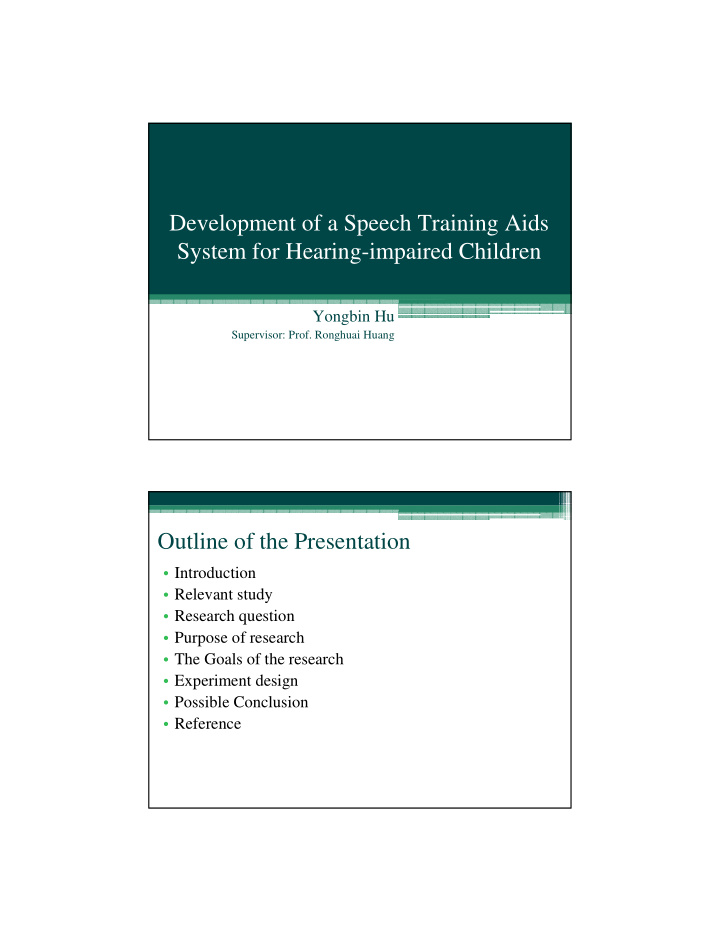



Development of a Speech Training Aids System for Hearing-impaired Children Yongbin Hu Supervisor: Prof. Ronghuai Huang Outline of the Presentation � Introduction � Relevant study � Research question � Purpose of research � The Goals of the research � Experiment design � Possible Conclusion � Reference
Introduction � According to the figures provided by China Federation of Handicapped People (CFHP), there are about 250 million people with hearing impairment in the world, and more than 20.57 million of them are in China. � Due to the language barrier, hearing-impaired people are difficult to integrate into society, and they encountered unimaginable difficulties in the process of living and working. � Most hearing-impaired children have some residual hearing, they can be equipped with hearing aids or a cochlear implant, and their auditory function can be improved. Introduction � How to enhance the language abilities of hearing- impaired children is a hot topic in the world academic community. � Speech training aids for hearing-impaired individuals emerges from 1930s. (L. Bernstein, 1988) � Speech training aids is a procedure which uses all kind of technology, strategy, and method to improve hearing ability and verbal language development of hearing- impaired children. (Levitt, H., & Oden, C. 2011).
Introduction � Using effective speech training aids system (STAS), and carrying out specific training programs in the critical language learning phase, the language ability of hearing- impaired children can be enhanced. Relevant studies in abroad � The STAS provides the learner with sound, pictures or videos to instruct the children to pronounce words. (Nickerson et al.,1976;Sheila R.P.et al.,1993) � Using a microphone, camera, and other devices, the STAS could provide more information in great detail. After analyzing the presentation on the screen, such as loudness, pitch, spectrum of voice and articulator movement, the children can compare the gathered data with the ideal graphics. (A. Oster, 1995.)
Relevant studies in abroad � Using artificial intelligence technology, the STAS will evaluate the pronunciation and then provide feedback to the children. (R. See et al, 2013;H. Zhou et al, 2013) Relevant study in China According to my investigation, Dr. Speech is the only one system which was used in China. However, the designer of Dr. Speech ignore the significance of Chinese Pinyin , its practicability is limited . Chinese Pinyin is a basic learning content, and it is the foundation of Chinese language.
Research question • What is the characteristics of hearing-impaired children in Chinese language learning? • How to design and develop a Chinese language Speech Training Aided System (CLSTAS) for them in language training? • How to use the CLSTAS to enhance Chinese language learning? Purpose of research • Based on the characteristics of hearing-impaired children, this research will design and develop Chinese language Speech Training Aided System (CLSTAS) to support their speech training.
The contents of the research � Investigate the characteristics of hearing-impaired children in Chinese language learning � Design and develop a CLSTAS � Sound Recognition Training: enhanced the hearing ability to recognize environmental sounds. � Pinyin teaching : how to recognize initials, finals, and syllables, through hearing, recognition, seeing, reading and writing. � Design learning activity for them � Evaluate the CLSTAS’s performance � Design a experiment to compare different groups. � Investigate teachers’ attitude and experience. Experiment design 1.Participants � Twenty hearing-impaired children from Nanjing Deaf School will participate in this study. � We will use quasi-experimental study to evaluate the performance of the system. The participants will be divided into two groups based on their pre-testing performance. One will be an experimental group, and the other will be control group.
Experiment design 2.Research tools The research tools in this study included Chinese Communicative Development Inventory (CCDI) Mandarin Version and Written and Spoken Skill Tests (WSST). WSST was developed by two experienced teachers. WSST evaluated the degree of accuracy (100%) and degree of fluency (100%) of the pronunciation. Experiment design 20 hearing-impaired children 3. Experiment Procedures 60 Pre-test Six pinyin letters, including minutes three initials and three Experimental group Control group N=10 N=10 finals, were selected as the 120 minute, learning materials. The 3 days Speech training with Speech training with children in the experimental SATS traditional approach group were guided by STAS while the children in 60 Post-test minutes the control group learned with traditional.
Possible Conclusion � The levels of speech accuracy and speech influence of the children will be improved with the help of CLSTAS. � The children and teachers will feel CLSATS is usefulness. � The proposed learning activity design is more effective than the traditional approaches. Possible Conclusion [1] L. Bernstein, M. Goldstein, and J. Mahshie, “Speech training aids for hearing-impaired individuals: I. Overview and aims,” Journal of rehabilitation …, 1988. [2] Zhou Jing (2002). Emphasis on children's ability to use language development [J]. Studies In Preschool Education,(3):8-10. [3] Hatch, E.M. (1983,. Psycholinguistics: A Second Language Perspective Newbury House, Massachusetts. [4] Bao Xiulan (2003). the importance of education on 0-3 year old children.[J]. Journal of Applied Clinical Pediatrics, 18(4):243-244. [5Nickerson et al., (1976). Computer-aided speech training for the deaf [J]. Speech Hearing Disorders, (41):120-132. [6] Sheila R.P., Anne T.H., &Susan E.D.(1993).The Efficacy of Using the IBM Speech Viewer Vowel Accuracy Module to Treat Young Children With Hearing Impairment [J]. Computer-Aided Speech Training for the Deaf, 36: 1063-1074 [7] A. Öster, “Teaching speech skills to deaf children by computer-based speech training,” STL- Quarterly Progress and Status Report, 1995. [8] R. See and V. Driscoll, “Speech Intonation and Melodic Contour Recognition in Children With Cochlear Implants and With Normal Hearing,” Otology & …, 2013. [9] H. Zhou, Z. Chen, H. Shi, Y. Wu, and S. Yin, “Categories of Auditory Performance and Speech Intelligibility Ratings of Early-Implanted Children without Speech Training,” PloS one, 2013. [10]Wang Feng, Hu Xujun(2001). Comparing The Visual Attention Between Hearing - impaired Children and Normal Children [J]. Chinese Journal of Special Education, (4): 32-34.
Recommend
More recommend